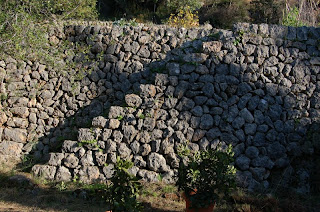 And a pretty dry one it's been, with no real rain since January. Now into September and it seems the whole of the western Mediterranean has had rain but not Mallorca. However the water is still flowing, at a reduced rate, but there's still plenty of it for our needs. In terms of temperature, June was hot, July exceptionally cool, the whole of August hot. When I say hot, there have been no exceptional temperatures and no xaloc (sirocco), just steady in the range of 22-25C min, 28-30 max.
And a pretty dry one it's been, with no real rain since January. Now into September and it seems the whole of the western Mediterranean has had rain but not Mallorca. However the water is still flowing, at a reduced rate, but there's still plenty of it for our needs. In terms of temperature, June was hot, July exceptionally cool, the whole of August hot. When I say hot, there have been no exceptional temperatures and no xaloc (sirocco), just steady in the range of 22-25C min, 28-30 max.
First and foremost the trees: all surviving, bar one orange that never looked happy from the start. The nectarines have had a touch of mildew but have still grown vigourously. Fig, kaki, loquat and some of the citrus have grown quite a bit and are looking good. The rest of the citrus is holding up but not grown much, likewise the avocadoes. Of course how much water and how often are the crucial questions with new trees. Initially I had a cheap moisture meter with a probe about 20cm long; this was incredibly useful in gaugeing when to
water. Unfortunately it did not have a high resistance to being pushed in and out of stony ground, and soon broke. I now have another but am wary of using it unless its really needed. Generally the stone fruit seem to be OK up to 10 days between watering, or a week when it's very hot. The citrus and avos I did every 4-5 days in the hottest weather, paying more attention after the cumquat lost all its blossom. The loquat is either very thirsty or in a spot that dries very rapidly, and it has had the same sort of routine as the citrus. I have been using a hoop of 10mm pipe with lots of holes in it, and running water for about 15 minutes. Not all that precise and measured, but seems to have got them through. The idea is to use a bigger hoop next year to extend the roots.
As for the veg, some hits and some not so goods, but we have had a good variety for the table throughout the summer, without any excessive gluts (partly due to the failure of some crops). Tomatoes were not a huge success, but we have had a reasonably supply for salads, pa'amb oli and Asian cooking, but not enough to bottle, freeze or dry. The big ones came in a flush in July, with a second one in late August, but the cherries kept up a continuous production and are still going. Problems: feeding with the drip-feed - need to use a hose periodically to wash in the surface fertiliser dressing, and I probably was not sufficiently dilligent about this; mildew - everyone gets it and dusts with copper sulfate, but my plants still seemed to have it; last but not least, a new pest here, a caterpillar that burrows into the tomato making a mess of it. There is apparently a biological remedy for this, I will certainly try it next year. On the plus side, no blossom-end rot or splitting, so I must have got it more or less right with the watering (daily, at about 5l per plant).
Things that did well are aubergines, chillies, kangkung, cucumbers and pumpkins - all the things that really like it hot. Beans we had in May and again in later summer and hopefully on into autumn. Cobra and hunter have been great, won't bother again with lingua di fuoco - not much flavour. Lesson: don't make a frame higher than you can reach. You see a lot of arbour-style frames for beans, so you walk underneath to pick them. Corn was a mixed bag - earlibird went well, the locally-sourced seed didn't. Also grew some minipop which might have messed up the other corn by cross-pollinating. In anycase, very poor SVR (space value return, after Joy Larkcom) from minipop.
One lesson learned on Thai basils: horapa grows much better if planted out singly, about 25cm between plants, than if clumped. If kept well watered, fed a high N fert, and regularly picked, one patch goes all summer. If neglected it just goes to seed and the flavour suffers. Kaprao seems to not mind being planted in bunches, but seems to need more heat - it didn't really get going until July, but is still going strong in mid-september.
Sarting a new blog called Dan's kitchen alconasserkitchen.blogspot.com with some cookery ideas born out of the veg garden. Please come and have a look.

















